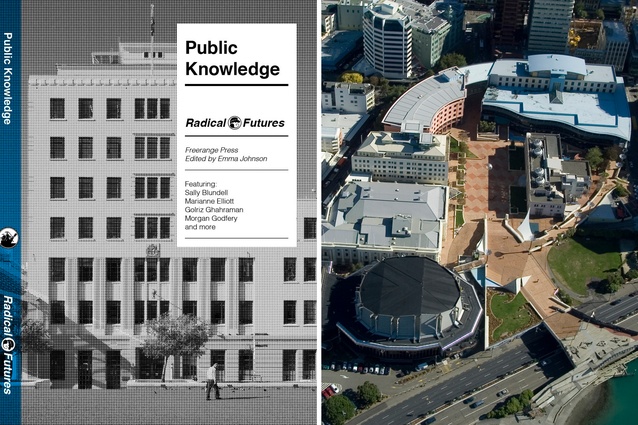Review: Public Knowledge
Paul Walker looks at the book Public Knowledge, the second volume in the Radical Futures series (Freerange Press, 2020), a collection of essays focusing on future challenges that affect us all.
American architect Robert Venturi once said Americans didn’t need piazzas because they should be at home watching television. It was a controversial warning against false nostalgia for physical manifestations of a public that can no longer be made co-present in real space. In the current COVID-19 lockdowns, it also seems weirdly prescient. Is this book also motivated by a kind of nostalgia? Or prescience?
Nostalgia might be signalled in the two architectural images the book contains: one of the Wellington City Council building (on its cover) and the other the ‘piazza’ where that building sits – Athfield’s Wellington Civic Square. It is not that nostalgia is entirely a bad thing: Wellington’s square was an assertion of a civic realm as an ideal, even when it was merely a representation of such a thing. The public as reality and representation – these ideas played across my mind as I read the essays in this book.
Jared Davidson starts the collection off with a passionately written denouncement of the disinterested nature of public archives: “Because if we truly want to get at the root of the social and ecological disaster that is capitalism, knowledge in itself is not enough. Knowledge must be used, and in ways that radically rupture and reorient our current modes of relationship – including our relationship to knowledge itself.” Yeah, right on! But this statement is at the conclusion of Davidson’s essay; we never get to how archival knowledge might be used to such ends.
Next comes Joseph Hullen’s piece on the practices of Māori knowledge. Hullen discusses the importance of marae protocols in the transmission of this knowledge, and more generally the importance of the lived experience of places in our bringing knowledge to bear in their care. Then Gwynn Compton, a PR type who advised John Key on social media. His chapter is a warning against the increasing digital fragmentation of public discourse. Sally Blundell’s chapter follows on logically from Compton’s. Cleverly using the subtitles ‘Not Us’ and ‘Us’, she focuses alternately on the inclusive rhetoric of much of the public discourse that followed on from the Christchurch mosque killings and the online communities of hatred that fed the violence. Her solution? More education on these matters in schools and the humanities departments of universities.
You get the picture – four essays in and, apart from Hullen’s gentle words, I was in mild despair. It is not that the views put in these pieces are wrong-headed or disagreeable. Nor is it that the essays are poorly written: far from it. This collection suggests that, currently, New Zealand has a wonderfully literate commentariat, established and emerging (or that the editor has used her skills astutely). It is just that no prescription is offered for the problems diagnosed, or otherwise a prescription akin to aspirin for Ebola.
Among the rest of the essays, Lana Lopesi’s is a standout. Noting that the Samoan diaspora has been early adopters of social media to maintain their sense of community and connection, she comments that the online environment ‘has enabled the formation of different kinds of publics and provided a platform for those who normally don’t have seats within the mainstream media’. Digital connectivity and collectivity are empowering: online here is good. Lopesi leads us to think that publics positively proliferate rather than settling into a decorous singularity, no matter how inclusive.
Nicola Gaston’s chapter is a reminder of the public good of universities, and Golriz Ghahraman’s a reflection on the rights to free speech and their limitations. The rest of the essays are just as worthy. The best of these for my money is Sacha McMeeking’s. McMeeking suggests public knowledge needs to be felt as well as understood. “Compassion fatigue” is a risk associated with the documentary mode: “asking the reader to imagine the hypothetical lived causation of Māori disparity… will have far less impact than if there was an experience that enabled that reality to be felt….”
Public Knowledge, then, is fairly grim reading. And maybe it should be. Mostly, the essays offer no proposals for the radical futures promised by the book’s subtitle. This, however, is not true of Barnaby Bennett’s, the last of the book’s essays and therefore a kind of conclusion. Turning to the ability of physical spaces to make publics manifest – in effect answering Venturi’s old cynicism – Bennett comments on three kinds of such spaces: co-working spaces, new public libraries, and – most productive of all – transitional places of the kind that became prevalent after the Christchurch earthquakes. Bennett’s final paragraph:
“The reactivation of public space, and the associated regeneration of public trust, raises the potential of there being a new kind of citizen – one that is created and sustained by these spaces’ commitment to local ways of being, and the associated public knowledge and practices. This, in turn, could lead to the creation of a bigger and more differentiated world.”
In the age of pandemic, however, that ‘bigger and more differentiated world’ will in the meantime not be physical. It will have to be realised online.
Read Barnaby Bennett’s full essay here, and click here to purchase a copy of Public Knowledge online.










